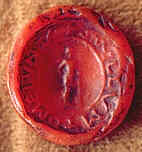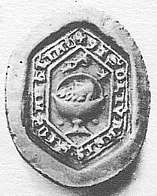



If you are looking at this page without frames, there is more information about medieval writing to be found by going to the home page (framed) or the site map (no frames).
| Seals of Clergy (2) | ||||||
| As well as their seals of dignity, senior clergy used smaller personal seals in a clerical equivalent of a privy seal or signet. These were used for documents of less weight and moment than those which required their major seal. | ||||||
 |
Personal seal of Thomas Beckett, from a facsimile. | |||||
| Archbishop Thomas Beckett's personal seal was derived from a carved antique intaglio gem, set with an inscription around it. The figure is supposed to represent a naked figure of Mars or Mercury wearing a helmet, although you would have to have a vivid imagination to work that out from this image. Nevertheless, it is derived from an ancient pagan source rather than Christian imagery. | ||||||
| These seals sometimes served as a counterseal for the seal of dignity, and could bear a somewhat similar range of motifs as those, in a more simplified presentation. | ||||||
 |
||||||
| At left, the counterseal of Thomas de Mauléon, abbot of St Germain-des-Prés, of 1251; centre, counterseal of Olivier, abbot of Saint-Jean-d'Angély, of 1301; at right, counterseal of Jean, abbot of Longpont, of 1261. (From de Boüard 1929) | ||||||
| The example on the left shows the abbot in his vestments carrying his pastoral staff. The second shows a chalice, commonly used as a symbol of the priestly office, with what appears to be a hand in benediction above it. The third is a more petitie version of an image of the abbey church building. | ||||||
| The example at right draws from the repertoire of religious art, depicting the Annunciation, a scene in miniature as depicted in many other media. | ||||||
| Counterseal of Pierre II de Barrière, bishop of Senlis, of 1328. (From de Boüard 1929) | ||||||
| The signet was an even smaller and more personal item. This one just displays the prior's tonsured head. | ||||||
| Signet of Nicholas de Noyelette, prior of Notre-Dame-du-Perron-lez-Béthume, of 1355. (From de Boüard 1929) | ||||||
 |
A modest example, somewhat mutilated, shows a cleric handing out alms to a figure with outstretched hands, indicating the owner's vocation rather than his fancy family connections. | |||||
| Seal of Henry de Bluntesdon, archdeacon of Dorset, on a document of 1311 (Westminster Abbey Muniments, No.6227). (From New Palaeographical Society 1910) | ||||||
 |
This quaint little seal shows what one can only assume to be a figure of the priest kneeling before the Virgin and child. | |||||
| Seal of Alexander de Astelyne, clerk. | ||||||
| This one shows a funny little stylised image of the church building. | ||||||
| Signet of Jean Port, priest of Notre-Dame de Calais, of 1305. (From de Boüard 1929) | ||||||
| The seals of the clergy therefore used either specifically religious symbolism, or imagery of a more secular nature including heraldry, or a combination of both. A 17th century drawing records the seal of Odo, Bishop of Bayeux from 1071 to 1082, now lost. He was also earl of Kent and his seal, as recorded, shows the typical standing ecclesiastical figure on one side, and the standard equestrian motif of the aristocracy on the other. Although there is a fairly consistent set of stylised motifs, there are many changes that can be rung on them. | ||||||
|
|
||||||
|
|
||||||
|
|
||||||
|
If you are looking at this page without frames, there is more information about medieval writing to be found by going to the home page (framed) or the site map (no frames). |
||||||